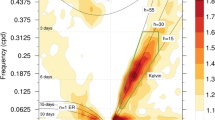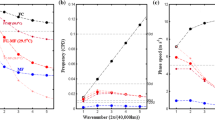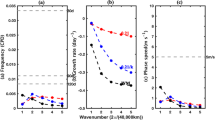Abstract
Mechanisms for an in-phase relationship between convection and low-level zonal wind and the slow propagation of the convectively coupled Kelvin wave (CCKW) are investigated by analyzing satellite-based brightness temperature and reanalysis data and by constructing a simple theoretical model. Observational data analysis reveals an eastward shift of the low-level convergence and moisture relative to the CCKW convective center. The composite vertical structures show that the low-level convergence lies in the planetary boundary layer (PBL) (below 800 hPa), and is induced by the pressure trough above the top of PBL through an Ekman-pumping process. A traditional view of a slower eastward propagation speed compared to the dry Kelvin waves is attributed to the reduction of atmospheric static stability in mid-troposphere due to the convective heating effect. The authors’ quantitative assessment of the heating effect shows that this effect alone cannot explain the observed CCKW phase speed. We hypothesize that additional slowing process arises from the effect of zonally asymmetric PBL moisture. A simple theoretical model is constructed to understand the relative role of the heating induced effective static stability effect and the PBL moisture effect. The result demonstrates the important role of the both effects. Thus, PBL-free atmosphere interaction is important in explaining the observed structure and propagation of CCKW.










Similar content being viewed by others
References
Back LE, Bretherton CS (2006) Geographic variability in the export of moist static energy and vertical motion profiles in the tropical Pacific. Geophys Res Lett 33:L17810. doi:10.1029/2006gl026672
Betts AK, Miller MJ (1986) A new convective adjustment scheme. Part II: single column tests using GATE wave, BOMEX, ATEX and arctic air-mass data sets. Q J R Meteorol Soc 112:693–709. doi:10.1002/qj.49711247308
Chan KM, Wood R (2013) The seasonal cycle of planetary boundary layer depth determined using COSMIC radio occultation data. J Geophys Res Atmos 118:12422–12434. doi:10.1002/2013jd020147
Chang CP, Lim H (1988) Kelvin wave-CISK: a possible mechanism for the 30–50 day oscillations. J Atmos Sci 45:1709–1720. doi:10.1175/1520-0469(1988)045<1709:kwcapm>2.0.co;2
Chen WY (1982) Fluctuations in Northern Hemisphere mb height field associated with the Southern Oscillation. Mon Weather Rev 110:808–823. doi:10.1175/1520-0493(1982)110<0808:finhmh>2.0.co;2
Dee DP et al (2011) The ERA-Interim reanalysis: configuration and performance of the data assimilation system. Q J R Meteorol Soc 137:553–597. doi:10.1002/qj.828
Dunkerton TJ, Crum FX (1995) Eastward propagating ~ 2- to 15-day equatorial convection and its relation to the tropical intraseasonal oscillation. J Geophys Res Atmos (1984–2010) 100:25781–25790
Emanuel KA (1986) An air-sea interaction theory for tropical cyclones. Part I: steady-state maintenance. J Atmos Sci 43:585–605
Emanuel KA (1987) An air–sea interaction model of intraseasonal oscillations in the tropics. J Atmos Sci 44:2324–2340
Emanuel KA, David Neelin J, Bretherton CS (1994) On large-scale circulations in convecting atmospheres. Q J R Meteorol Soc 120:1111–1143
Hayashi Y (1970) A theory of large-scale equatorial waves generated by condensation heat and accelerating. J Meteorol Soc Jpn Ser II 48:140–160
Hodges KI, Chappell DW, Robinson GJ, Yang G (2000) An improved algorithm for generating global window brightness temperatures from multiple satellite infrared imagery. J Atmos Ocean Technol 17:1296–1312. doi:10.1175/1520-0426(2000)017<1296:aiafgg>2.0.co;2
Holton JR (1992) An introduction to dynamic meteorology, 3rd edn. Academic Press, San Diego
Hsu P-C, Li T (2012) Role of the boundary layer moisture asymmetry in causing the eastward propagation of the Madden–Julian Oscillation*. J Clim 25:4914–4931. doi:10.1175/jcli-d-11-00310.1
Hsu P-C, Li T, Murakami H (2014) Moisture asymmetry and MJO eastward propagation in an Aquaplanet General Circulation Model*. J Clim 27:8747–8760
Kikuchi K, Takayabu YN (2004) The development of organized convection associated with the MJO during TOGA COARE IOP: trimodal characteristics. Geophys Res Lett 31:L10101. doi:10.1029/2004gl019601
Kiladis GN, Wheeler MC, Haertel PT, Straub KH, Roundy PE (2009) Convectively coupled equatorial waves. Rev Geophys. doi:10.1029/2008rg000266
Kim J-E, Alexander MJ (2013) Tropical precipitation variability and convectively coupled equatorial waves on submonthly time scales in reanalyses and TRMM. J Clim 26:3013–3030. doi:10.1175/jcli-d-12-00353.1
Kuang Z (2008) A moisture-stratiform instability for convectively coupled waves. J Atmos Sci 65:834–854. doi:10.1175/2007jas2444.1
Kuo HL (1974) Further studies of the parameterization of the influence of cumulus convection on large-scale flow. J Atmos Sci 31:1232–1240. doi:10.1175/1520-0469(1974)031<1232:FSOTPO>2.0.CO;2
Lau K-M, Peng L (1987) Origin of low-frequency (intraseasonal) oscillations in the tropical atmosphere. Part I: basic theory. J Atmos Sci 44:950–972
Li T (2014) Recent advance in understanding the dynamics of the Madden-Julian oscillation. J Meteorol Res 28:1–33. doi:10.1007/s13351-014-3087-6
Li T, Wang B (1994) The influence of sea surface temperature on the tropical intraseasonal oscillation: a numerical study. Mon Weather Rev 122:2349–2362. doi:10.1175/1520-0493(1994)122<2349:tiosst>2.0.co;2
Lin J-L et al (2006) Tropical intraseasonal variability in 14 IPCC AR4 Climate Models. Part I: convective signals. J Clim 19:2665–2690. doi:10.1175/jcli3735.1
Lindzen RS (1974) Wave-CISK in the tropics. J Atmos Sci 31:156–179. doi:10.1175/1520-0469(1974)031<0156:wcitt>2.0.co;2
Liu F, Wang B (2012a) A model for the interaction between 2-day waves and moist Kelvin Waves*. J Atmos Sci 69:611–625. doi:10.1175/jas-d-11-0116.1
Liu F, Wang B (2012b) A frictional skeleton model for the Madden–Julian Oscillation*. J Atmos Sci 69:2749–2758. doi:10.1175/jas-d-12-020.1
Liu F, Wang B (2013) Impacts of upscale heat and momentum transfer by moist Kelvin waves on the Madden–Julian oscillation: a theoretical model study. Clim Dyn 40:213–224. doi:10.1007/s00382-011-1281-0
Liu F, Wang B (2016) Effects of moisture feedback in a frictional coupled Kelvin-Rossby wave model and implication in the Madden–Julian oscillation dynamics. Clim Dyn. doi:10.1007/s00382-016-3090-y
Liu F, Chen Z, Huang G (2015) Role of delayed deep convection in the Madden-Julian oscillation. Theor Appl Climatol. doi:10.1007/s00704-015-1587-7
López Carrillo C, Raymond DJ (2005) Moisture tendency equations in a tropical atmosphere. J Atmos Sci 62:1601–1613. doi:10.1175/jas3424.1
Majda AJ, Shefter MG (2001) Models for stratiform instability and convectively coupled waves. J Atmos Sci 58:1567–1584. doi:10.1175/1520-0469(2001)058<1567:mfsiac>2.0.co;2
Maloney ED, Hartmann DL (1998) Frictional moisture convergence in a composite life cycle of the Madden–Julian Oscillation. J Clim 11:2387–2403. doi:10.1175/1520-0442(1998)011<2387:fmciac>2.0.co;2
Mapes BE (2000) Convective inhibition, subgrid-scale triggering energy, and stratiform instability in a toy tropical wave model. J Atmos Sci 57:1515–1535. doi:10.1175/1520-0469(2000)057<1515:cisste>2.0.co;2
Matsuno T (1966) Quasi-geostrophic motions in the equatorial area. J Meteorol Soc Jpn 44:25–43
Matthews AJ, Lander J (1999) Physical and numerical contributions to the structure of Kelvin Wave-CISK Modes in a spectral transform model. J Atmos Sci 56:4050–4058. doi:10.1175/1520-0469(1999)056<4050:panctt>2.0.co;2
McGrath-Spangler EL, Denning AS (2013) Global seasonal variations of midday planetary boundary layer depth from CALIPSO space-borne LIDAR. J Geophys Res Atmos 118:1226–1233. doi:10.1002/jgrd.50198
Mekonnen A, Thorncroft CD, Aiyyer AR, Kiladis GN (2008) Convectively coupled Kelvin waves over tropical Africa during the boreal summer: structure and variability. J Clim 21:6649–6667. doi:10.1175/2008jcli2008.1
Mounier F, Kiladis GN, Janicot S (2007) Analysis of the Dominant mode of convectively coupled Kelvin waves in the West African monsoon. J Clim 20:1487–1503. doi:10.1175/jcli4059.1
Neelin JD, Held IM (1987) Modeling tropical convergence based on the moist static energy budget. Mon Weather Rev 115:3–12. doi:10.1175/1520-0493(1987)115<0003:mtcbot>2.0.co;2
Neelin JD, Held IM, Cook KH (1987) Evaporation-wind feedback and low-frequency variability in the tropical atmosphere. J Atmos Sci 44:2341–2348. doi:10.1175/1520-0469(1987)044<2341:ewfalf>2.0.co;2
Nguyen H, Duvel J-P (2008) Synoptic wave perturbations and convective systems over equatorial Africa. J Clim 21:6372–6388. doi:10.1175/2008jcli2409.1
Raymond DJ, Fuchs Ž (2007) Convectively coupled gravity and moisture modes in a simple atmospheric model. Tellus A 59:627–640. doi:10.1111/j.1600-0870.2007.00268.x
Raymond DJ, Sessions SL, Sobel AH, Fuchs Ž (2009) The mechanics of gross moist stability. J Adv Model Earth Syst. doi:10.3894/james.2009.1.9
Roundy PE (2008) Analysis of convectively coupled Kelvin waves in the Indian Ocean MJO. J Atmos Sci 65:1342–1359. doi:10.1175/2007jas2345.1
Roundy PE, Frank WM (2004) A climatology of waves in the equatorial region. J Atmos Sci 61:2105–2132. doi:10.1175/1520-0469(2004)061<2105:acowit>2.0.co;2
Straub KH, Kiladis GN (2002) Observations of a convectively coupled Kelvin wave in the eastern Pacific ITCZ. J Atmos Sci 59:30–53. doi:10.1175/1520-0469(2002)059<0030:ooacck>2.0.co;2
Straub KH, Kiladis GN (2003a) Extratropical forcing of convectively coupled Kelvin waves during austral winter. J Atmos Sci 60:526–543. doi:10.1175/1520-0469(2003)060<0526:efocck>2.0.co;2
Straub KH, Kiladis GN (2003b) The observed structure of convectively coupled Kelvin waves: comparison with simple models of coupled wave instability. J Atmos Sci 60:1655–1668. doi:10.1175/1520-0469(2003)060<1655:tosocc>2.0.co;2
Straub KH, Kiladis GN, Ciesielski PE (2006) The role of equatorial waves in the onset of the South China Sea summer monsoon and the demise of El Niño during 1998. Dyn Atmos Oceans 42:216–238. doi:10.1016/j.dynatmoce.2006.02.005
Straub KH, Haertel PT, Kiladis GN (2010) An analysis of convectively coupled Kelvin waves in 20 WCRP CMIP3 global coupled climate models. J Clim 23:3031–3056. doi:10.1175/2009jcli3422.1
Ventrice MJ, Thorncroft CD, Janiga MA (2012a) Atlantic tropical cyclogenesis: a three-way interaction between an African easterly wave, diurnally varying convection, and a convectively coupled atmospheric Kelvin wave. Mon Weather Rev 140:1108–1124. doi:10.1175/mwr-d-11-00122.1
Ventrice MJ, Thorncroft CD, Schreck CJ (2012b) Impacts of convectively coupled Kelvin waves on environmental conditions for Atlantic tropical cyclogenesis. Mon Weather Rev 140:2198–2214. doi:10.1175/mwr-d-11-00305.1
von Engeln A, Teixeira J (2013) A planetary boundary layer height climatology derived from ECMWF reanalysis data. J Clim 26:6575–6590. doi:10.1175/jcli-d-12-00385.1
Wang B (1988) Dynamics of tropical low-frequency waves: an analysis of the moist Kelvin wave. J Atmos Sci 45:2–051
Wang H, Fu R (2007) The influence of Amazon rainfall on the Atlantic ITCZ through convectively coupled Kelvin waves. J Clim 20:1188–1201. doi:10.1175/jcli4061.1
Wang B, Li T (1993) A simple tropical atmosphere model of relevance to short-term climate variations. J Atmos Sci 50:260–284. doi:10.1175/1520-0469(1993)050<0260:astamo>2.0.co;2
Wang B, Li T (1994) Convective interaction with boundary-layer dynamics in the development of a tropical intraseasonal system. J Atmos Sci 51:1386–1400. doi:10.1175/1520-0469(1994)051<1386:ciwbld>2.0.co;2
Wang B, Liu F (2011) A model for scale interaction in the Madden–Julian Oscillation*. J Atmos Sci 68:2524–2536. doi:10.1175/2011jas3660.1
Wheeler M, Kiladis GN (1999) Convectively coupled equatorial waves: analysis of clouds and temperature in the wavenumber–frequency domain. J Atmos Sci 56:374–399. doi:10.1175/1520-0469(1999)056<0374:ccewao>2.0.co;2
Wheeler M, Kiladis GN, Webster PJ (2000) Large-scale dynamical fields associated with convectively coupled equatorial waves. J Atmos Sci 57:613–640. doi:10.1175/1520-0469(2000)057<0613:lsdfaw>2.0.co;2
Xie X, Wang B (1996) Low-frequency equatorial waves in vertically sheared zonal flow. Part II: unstable waves. J Atmos Sci 53:3589–3605. doi:10.1175/1520-0469(1996)053<3589:lfewiv>2.0.co;2
Yanai M, Esbensen S, Chu J-H (1973) Determination of bulk properties of tropical cloud clusters from large-scale heat and moisture budgets. J Atmos Sci 30:611–627. doi:10.1175/1520-0469(1973)030<0611:dobpot>2.0.co;2
Yang G-Y, Hoskins B, Slingo J (2003) Convectively coupled equatorial waves: a new methodology for identifying wave structures in observational data. J Atmos Sci 60:1637–1654. doi:10.1175/1520-0469(2003)060<1637:ccewan>2.0.co;2
Yang G-Y, Hoskins B, Slingo J (2007a) Convectively coupled equatorial waves. Part I: horizontal and vertical structures. J Atmos Sci 64:3406–3423. doi:10.1175/jas4017.1
Yang G-Y, Hoskins B, Slingo J (2007b) Convectively coupled equatorial waves. Part II: propagation characteristics. J Atmos Sci 64:3424–3437. doi:10.1175/jas4018.1
Yano J-I, Emanuel K (1991) An improved model of the equatorial troposphere and its coupling with the stratosphere. J Atmos Sci 48:377–389. doi:10.1175/1520-0469(1991)048<0377:aimote>2.0.co;2
Yu J-Y, Chou C, Neelin JD (1998) Estimating the gross moist stability of the tropical atmosphere*. J Atmos Sci 55:1354–1372. doi:10.1175/1520-0469(1998)055<1354:etgmso>2.0.co;2
Acknowledgments
The authors thank valuable discussions with Dr. Guosen Chen and Dr. Lei Zhang. This study is jointly supported by China National 973 project 2015CB453200, NSFC Grant 41475084, ONR Grant N00014-16-12260, Jiangsu NSF Key project (BK20150062), Jiangsu Shuang-Chuang Team (R2014SCT001), the Priority Academic Program Development of Jiangsu Higher Education Institutions (PAPD), and the International Pacific Research Center sponsored partially by the Japan Agency for Marine-Earth Science and Technology (JAMSTEC). The present results were obtained using the CLAUS archive held at the British Atmospheric Data Centre, produced using ISCCP source data distributed by the NASA Langley Data Center. This is SOEST Contribution Number 9639, IPRC Contribution Number 1197 and ESMC Number 113.
Author information
Authors and Affiliations
Corresponding author
Appendix: Derivation of the 2.5-layer model for CCKW
Appendix: Derivation of the 2.5-layer model for CCKW
Consider a simple atmospheric model that consists of two-level atmosphere and a well-mixed planetary boundary layer (PBL) (see Fig. 11), where p s, p e and p 0 stand for pressures at the surface, the top of PBL and the top of free atmosphere, respectively. The free atmosphere is divided by two equal pressure levels with \(p_{2} = (p_{0} + p_{e} )/2\). Neglecting the meridional wind component, the horizontal momentum and continuity equations are written at levels p 1 (\(p_{1} = (p_{2} + p_{0} )/2\)) and p 3 (\(p_{3} = (p_{2} + p_{e} )/2\)) and thermodynamic equation at p 2.
where C p is specific heat at constant pressure; \(u\), \(\phi\) and \(\omega\) denote the zonal wind, geopotential and vertical pressure velocity respectively; \(\sigma_{2}\) and \(\dot{Q}\) are the static stability parameter and the diabatic heating rate at p 2 respectively; \(\Delta p\) is the half-depth of the free atmosphere (\(\Delta p = (p_{e} - p_{0} )/2\)).
Introducing barotropic and baroclinic components of zonal winds and geopotentials defined by
The sums and differences of corresponding momentum and continuity equations at levels p 1 and p 3 then yield
By assuming \(\omega_{e} = \omega_{0}\), the barotropic and baroclinic modes are decoupled; this assumption was shown to be quite useful to simplify tropical atmospheric motion (Wang and Li 1993). As a result, one only needs to consider the linear governing Eqs. (21–23), with \(u_{ - }\) and \(\phi_{ - }\) representing lower tropospheric zonal wind and geopotential anomaly fields, respectively. The mid-tropospheric vertical motion is determined by the vertical motion at the top of PBL and the low-level convergence as
Following Wang and Li (1993), PBL momentum and continuity equations may be written as
where \(u_{B}\) and \(v_{B}\) are vertically averaged horizontal winds in the boundary layer; \(\phi_{e}\) denotes the geopotential at the top of PBL; E is the friction coefficient; \(\beta^{*}\) is the planetary vorticity gradient. Here we have assumed the vertical motion is zero at \(p_{s}\). As a result, \(\omega_{e}\) could be explicitly solved as a function of \(\phi_{e}\) (i.e., \(\omega_{e} = \left( {p_{s} - p_{e} } \right)\left( {\frac{{\partial u_{B} }}{\partial x} + \frac{{\partial v_{B} }}{\partial y}} \right) = f(\phi_{e} )\)). For simplicity, one may directly link \(\omega_{e}\) to \(\phi_{e}\) as
where \(\beta_{0}\) is a scale parameter which could be estimated based on reanalysis data, and \(\phi_{e}\) may be approximately represented by \(\phi_{ - } .\)
Consider that atmospheric diabatic heating consists of two parts: a simultaneous heating process (denoted by \(\dot{Q}_{s}\)) associated with the deep convection of CCKW and a delayed heating process (denoted by \(\dot{Q}_{d}\)) related to PBL moistening ahead of the convection (i.e., \(\dot{Q} = \dot{Q}_{s} + \dot{Q}_{d}\)), where \(\dot{Q}_{s}\) is induced by the mid-level upward motion associated with the deep convection and could be parameterized as \(\dot{Q}_{s} = - I\sigma_{2} C_{p} p_{2} \omega_{2} /R,\) where I represents the ratio of the simultaneous heating against the adiabatic cooling; the \(\dot{Q}_{d}\) is associated with the pre-moistening of PBL. The effect of the PBL moistening at the east side of pre-existing CCKW convection is to destabilize the atmosphere through increased convective instability and induce the onset of shallow cumulus and congestus. The delayed heating process may be parameterized by the pre-moistening of PBL as
where β 1 is a scale parameter and τ 1 represents the time-lag between the PBL moisture (\(q_{B}\)) and the subsequent convective heating. Therefore, free-atmospheric governing equations may be written as
where \(C_{0} = \sqrt {{{\sigma_{2} \Delta p^{2} } \mathord{\left/ {\vphantom {{\sigma_{2} \Delta p^{2} } 2}} \right. \kern-0pt} 2}}\) denotes the dry Kelvin wave speed.
To reveal the cause of the pre-moistening in PBL, a vertically (1000–800 hPa) integrated moisture budget analysis was performed over the PBL moistening region (5°S–5°N, 100°–120°E). Applying a CCKW-filtering operator (denoted by a prime) to the total moisture tendency equation, one may derive the CCKW moisture budget equation as the following:
where \(Q_{2}\) is the atmospheric apparent moisture sink (Yanai et al. 1973) and L v is the latent heat of condensation. Figure 12 shows the contribution from each of the PBL moisture budget terms. The largest positive contribution is the vertical moisture advection term. The cause of the positive vertical advection is primarily due to the advection of the mean moisture (which has a maximum at the surface and decays with height) by anomalous ascending motion, in a way similar to the MJO moistening process (Hsu and Li 2012). For simplicity, a PBL moisture tendency equation may be written as \(\frac{{\partial q_{B} }}{\partial t} = - \omega_{B} \frac{{\partial \bar{q}}}{\partial p} = - \frac{{\omega_{e} }}{2}\frac{{\partial \bar{q}}}{\partial p} = \lambda \omega_{e}\) where \(\lambda = \frac{{\partial \bar{q}}}{2\partial p}\). As \(\omega_{e}\) is associated with the PBL convergence, which is mainly induced by the low pressure at the top of PBL through Ekman pumping effect (as demonstrated in Fig. 5), an alternative way is to directly link \(q_{B}\) to \(\omega_{e}\) or \(\phi_{e}\) with a time lag, based on reanalysis data analysis. Thus, the PBL moisture equation could be simplified as a linear diagnostic equation:
where β 2 is a scale parameter and \(\tau_{2}\) represents the time-lag between \(- \phi_{e}\) and \(q_{B}\).
PBL averaged CCKW moisture budget terms over the max PBL moistening tendency region (5°S–5°N, 100°–120°E). From left to right, observed specific humidity tendency, zonal moisture advection, meridional moisture advection, vertical moisture advection, latent heating and sum of these budget terms. Unit is 10−5 g kg−1 s−1
Equations (28)–(31) and (33) formulate a simple analytical model for CCKW, with the parameters β 0, β 1, β 2, \(\tau_{1}\) and \(\tau_{2}\) estimated by using the reanalysis data (discussed in Sect. 5.1).
Rights and permissions
About this article
Cite this article
Wang, L., Li, T. Roles of convective heating and boundary-layer moisture asymmetry in slowing down the convectively coupled Kelvin waves. Clim Dyn 48, 2453–2469 (2017). https://doi.org/10.1007/s00382-016-3215-3
Received:
Accepted:
Published:
Issue Date:
DOI: https://doi.org/10.1007/s00382-016-3215-3






